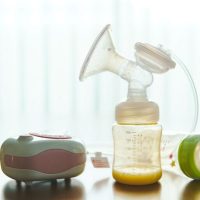The natural variation in breast milk’s fat content typically requires no active management. Below is an explanation of how this process works and why experts recommend allowing a baby to fully empty one breast before switching to the other during a feeding session.
A mother’s breast produces only one type of milk, which inherently contains a relatively high fat concentration. However, the fat content available to the baby changes gradually during a feed due to the mechanics of milk release. As milk is synthesized in the breast, fat globules tend to adhere to each other and to the walls of the alveoli (milk-producing sacs). Between feedings, milk accumulates in the breasts and slowly moves toward the nipple, leaving increasing amounts of fat “trapped” deeper in the milk ducts.
The timing between milk removal sessions (via feeding or pumping) directly impacts fat availability. The longer the interval, the lower the fat content in the milk accessible to the baby at the start of a feeding. This mechanism underscores the importance of allowing the baby to fully drain one breast first, ensuring they receive both the lower-fat foremilk (which hydrates and provides carbohydrates) and the higher-fat hindmilk (which delivers essential calories and nutrients).
Understanding Foremilk and Hindmilk
The terms foremilk and hindmilk describe milk consumed at different stages of a feeding session, not distinct types of milk. Foremilk refers to the milk available at the beginning of a feed, while hindmilk denotes the milk toward the end, which naturally contains higher fat content. The transition between these phases is gradual, with no abrupt shift—research by Peter Hartmann’s team confirms that fat levels correlate directly with breast emptiness: the less milk remaining, the higher the fat concentration.
Mechanics of Milk Release
During breastfeeding or pumping, the milk ejection reflex (MER) is activated, propelling milk through the ducts. This process involves multiple let-downs per feeding, though most mothers only notice the initial one. As the breast empties, fat globules detach from the alveoli and duct walls, gradually increasing the fat content of the milk. Imagine turning on a hot water tap: the first flow is cool, but it warms progressively as the tap runs. Similarly, milk fat rises steadily during a feed, peaking as the breast nears emptiness.
Factors Influencing Fat Content
Fat levels at the start of a feed depend on the time elapsed since the previous session. Longer intervals between feedings result in lower initial fat content, as stored milk separates, leaving fat “trapped” in the ducts. Conversely, frequent nursing or pumping maintains higher baseline fat levels, akin to using a hot tap soon after it was last turned on—the water starts warm rather than cold.
Practical Implications
As a feed progresses, fat content increases while milk volume and flow diminish. Since infants vary in how long they nurse to access hindmilk, it’s crucial to allow them to finish one breast before switching. Interrupting active feeding may deprive the baby of calorie-dense hindmilk, which supports satiety and growth. This dynamic underscores the importance of responsive feeding patterns tailored to each baby’s pace.
By recognizing these nuances, caregivers can optimize breastfeeding practices without undue concern over rigid definitions of foremilk and hindmilk.




